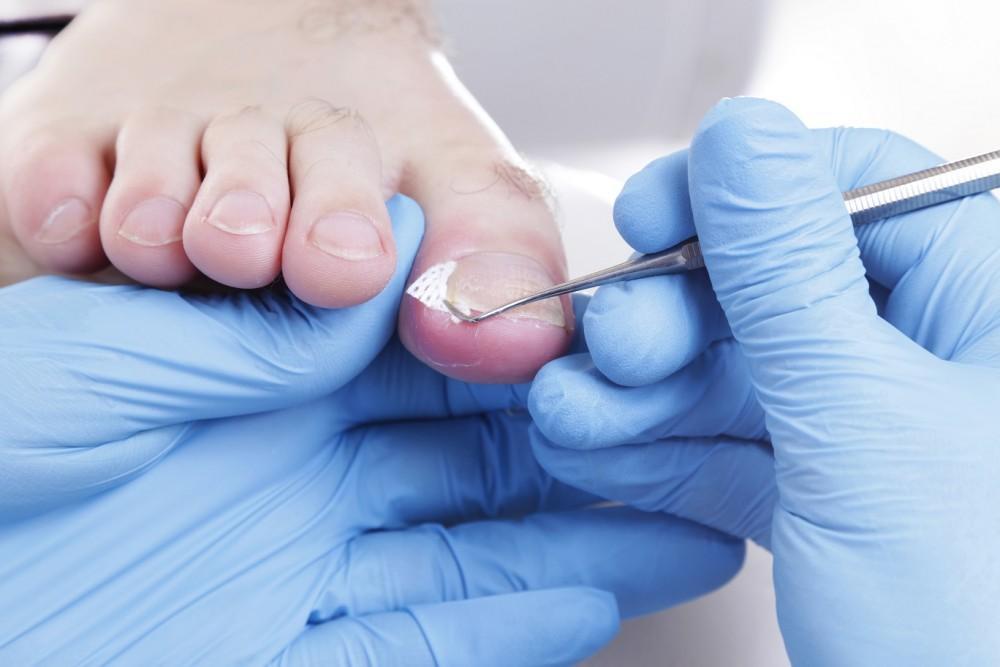Ingrown Toenail

Ingrown Toenails
An ingrown toenail, medically known as onychocryptosis, is a common and often painful foot condition. It occurs when the edge of the toenail grows into the surrounding skin, leading to redness, swelling, and potential infection. If untreated, it can cause significant discomfort and complications.

What Causes an Ingrown Toenail?
Several factors can lead to the development of an ingrown toenail:
1. Improper Footwear
• Wearing tight shoes or socks places pressure on the toes, forcing the nail into the surrounding skin.
2. Improper Nail Trimming
• Cutting toenails too short or with rounded edges increases the likelihood of the nail growing into the skin.
3. Trauma or Injury
• Stubbing your toe, repetitive pressure, or dropping heavy objects on the toe can result in abnormal nail growth.
4. Genetic Predisposition
• Some people are naturally prone to ingrown toenails due to the shape or curvature of their nails.
Symptoms of an Ingrown Toenail
• Early Symptoms:
• Pain or tenderness along the edge of the toenail.
• Swelling and redness around the affected area.
• Advanced Symptoms:
• Infection, characterized by pus, warmth, and severe redness.
• Difficulty walking or wearing shoes due to increased pain.
Treatment Options
Non-Surgical Treatment
In mild cases, ingrown toenails can be managed without surgery:
• Antibiotics: If an infection is present, your doctor may prescribe antibiotics to reduce inflammation and clear the infection.
• Soaking: Soaking the foot in warm, soapy water or an antiseptic solution several times a day can help reduce swelling and discomfort.
• Proper Nail Care: Avoid cutting nails too short and ensure straight trimming to prevent further irritation.
• Footwear: Wear loose, comfortable shoes and socks to reduce pressure on the affected area.
Surgical Treatment
For chronic or severe cases, surgery may be required. Procedures include:
1. Wedge Resection:
• The most common surgical approach where a small strip of the nail and its underlying nail bed are removed. This helps the nail grow properly without embedding into the skin.
• Typically, only one side of the nail is treated, but in some cases, both sides may need intervention.
2. Complete Nail Removal:
• In severe cases, the entire toenail and the nail bed rarely may need to be removed and in Those cases where the nailbed is removed, it prevents regrowth of the ingrown nail.
Procedure Details
• Type of Anesthesia: Surgery is usually performed as a day-case procedure / Admission under local or general anesthesia depending on the patient.
• Duration: The procedure typically takes 30 minutes approximately
Post-Operative Care
Proper post-surgical care is crucial for recovery and to minimize complications:
1. Dressing:
• A bulky dressing will be applied immediately after surgery to protect the wound.
• Do not remove this dressing for 4- 7 days unless instructed by your doctor.
2. Foot Elevation:
• Keep your foot elevated above the level of your heart as much as possible for the first 72 hours. This reduces swelling and bleeding, lowering the risk of infection.
3. Activity Restrictions:
• Avoid driving or strenuous activities immediately after surgery. Arrange for someone to transport you home.
4. Follow-Up Appointment:
• Ensure you schedule a post-operative check-up within 7–10 days for dressing change and removal of any sutures, if present.
Complications
While most surgeries for ingrown toenails are successful, complications can occur:
1. Infection: Though uncommon, infections can occur post-surgery and may require further treatment.
2. Recurrence: Despite surgical intervention, the nail may regrow abnormally in some cases.
Preventing Ingrown Toenails
Taking preventive steps can significantly reduce the risk of developing ingrown toenails:
• Trim Nails Properly: Cut nails straight across without rounding the edges.
• Choose Comfortable Footwear: Opt for shoes with ample toe space to avoid unnecessary pressure on your nails.
• Maintain Good Hygiene: Keep feet clean and dry to prevent bacterial growth.
• Monitor for Signs: If you notice pain, redness, or swelling, address it early to avoid complications.
When to See a Doctor?
If home treatments do not improve symptoms, or if there are signs of infection like pus or severe pain, consult a healthcare professional immediately.
Conclusion
Ingrown toenails, while common, can escalate into a serious issue if not managed properly. Early intervention, proper foot care, and in severe cases, surgical correction, can effectively treat the condition and prevent recurrence.
.png ?>)